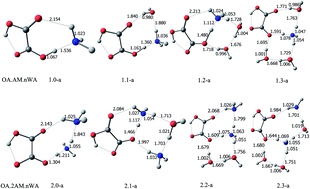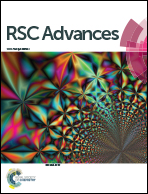Hydration of oxalic acid–ammonia complex: atmospheric implication and Rayleigh-scattering properties†
Abstract
A previous study of the binary system (H2C2O4)(NH3)n (n = 1–6) suggested that an oxalic acid–ammonia complex may participate in atmospheric aerosol formations. However, the mechanism of the hydration of these cores is poorly understood. In this study, the hydration of (H2C2O4)(NH3) and (H2C2O4)(NH3)2 cores with up to three water molecules is investigated with respect to different routes of formation. The results may improve understanding of the nucleation of clusters containing oxalic acid in the atmosphere. Acid dissociation is found to occur during the hydration process, leading to a HC2O4−/NH4+ ion pair. In contrast with the (H2C2O4)(NH3)2 core, water molecules appear to be unfavorable with regard to the formation of hydrates with a (H2C2O4)(NH3) core; additionally, temperature is found to affect the formation of clusters and the distributions of different isomers with the same size, but the impact of relative humidity on the hydrates seems insignificant, implying that the formation of these clusters may be more favorable under cold ambient conditions. The monohydrates and dihydrates of the (H2C2O4)(NH3)2 core may be relatively extensive in (H2C2O4)(NH3)m(H2O)n (m = 1–2, n = 1–3) clusters and may contribute to the atmospheric nucleation. Furthermore, this study presents a first attempt at determining the Rayleigh scattering properties of oxalic acid–ammonia–water pre-nucleation clusters; the results show that adding a water molecule could effectively increase the Rayleigh scattering intensity, but a single ammonia molecule may be able to generate a larger increase in the Rayleigh light scattering intensity than a water molecule. This may also indicate that clusters containing oxalic acid and ammonia show high Rayleigh light scattering intensities, but the more ammonia molecules there are in clusters, the higher the Rayleigh light scattering intensity and the greater the contribution to the extinction properties.


 Please wait while we load your content...
Please wait while we load your content...